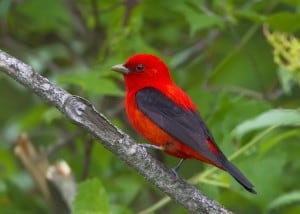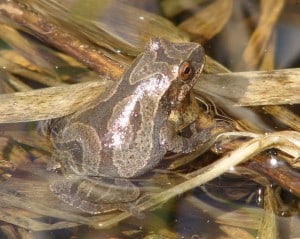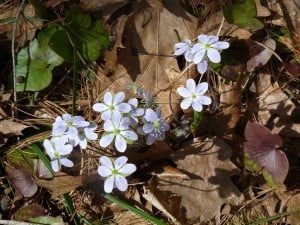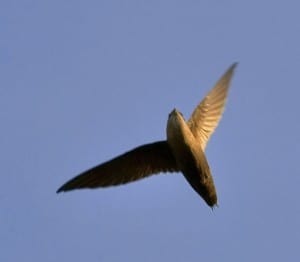For most anyone who enjoys the unfolding of a new season, spring stands head and shoulders above any other time of year. The greening of the landscape and explosion of animal life never fails to amaze. Spring is a season that regales all of the senses. Our ears reawaken to the chorus of bird and amphibian love song; our eyes delight in the return of leaves and flowers; our noses are tickled by the smell of lilac and balsam poplar; our taste buds are charmed by the first asparagus and strawberries; and our skin is enlivened by the first warm rains.
As spring advances, the Earth’s axis tilts increasingly toward the Sun. This results in a huge increase in the amount of heating of the northern hemisphere. The more direct solar radiation greatly accelerates photosynthesis and causes new plant growth to “spring forth” – hence the name of the new season. The green bounty fuels the entire food chain from caterpillars to songbirds.
Although the vernal equinox is not until Sunday, you couldn’t be blamed for thinking that spring has been with us now for weeks. Peterborough has been abnormally warm this winter. December’s average temperature was a staggering 8 C above normal, while January and February were both about 2 C higher than usual. March has already produced double-digit warmth on many days. Globally, the last three months were the most abnormally warm on record for any month. February’s global temperature departure of 1.35 degrees Celsius above the 1951-1980 average topped the previous records just set in January and December.
As a reminder of what to watch for in nature, I’m offering some mileposts of the spring months. If the unseasonable warmth continues, however, many of these events are likely to occur earlier than usual. Regardless of what the weather throws at us, the order of the events, which are listed chronologically, should remain the same.
Late March
- The buds of shrubs and trees like lilac, red-berried elder, red maple, and silver maple swell noticeably this month.
- Temperate zone migrants that overwintered in the U.S. are returning. In the city, the most notable new arrivals are robins and grackles. In rural areas, watch for red-winged blackbirds perched high in wetland trees. Listen, too, for the long, clear whistle of the eastern meadowlark and, in some areas, the rattling, bugle-like call of the sandhill crane. Wherever you are, keep an eye skyward for turkey vultures soaring northward.
- For anyone paying attention, the increase in bird song is hard to miss. If you don’t already know the voices of common songsters like the American robin and the song sparrow, this is a great time to start learning them. Go to allaboutbirds.org, enter the name of the species, and click on the Sound tab.
- Migrating waterfowl numbers are peaking early this year. With a bit of work, you should be able to find a dozen or more species. For mostly diving ducks, some hotspots include Little Lake, the Otonabee River, Lake Katchewanooka, Gannon Narrows, and Clear Lake at Young’s Point. Ring-necked ducks, buffleheads, lesser scaup, common goldeneye, and both common and hooded mergansers dominate. Puddle ducks such as northern pintails, American black ducks, green-winged teal and American wigeon often congregate in flooded fields such as the meltwater pond that forms each year at Mather’s Corners, located at the junction of County Road 2 and Drummond Line.
- The spring equinox occurs on March 20 as the sun shines directly on the equator. Both the moon and sun rise due east and set due west, and day and night are nearly equal in duration.
April
- April is a busy time for feeders. American tree sparrows and dark-eyed juncos move north through the Kawarthas in large numbers, sometimes accompanied by the beautiful, thrush-like fox sparrow. All of these species will occasionally break into song.
- The yellow, dandelion-like flowers we see growing in roadside ditches in early April are a non-native species known as coltsfoot.
- Close to 30 species of birds will be nesting this month. Among these are the Canada goose, mallard, bald eagle, red-tailed hawk, killdeer, American crow, blue jay, mourning dove, American robin, European starling, common grackle, northern cardinal, house finch, and house sparrow.
- For many rural residents, the return of the yellow-bellied sapsucker is hard to miss. This migratory woodpecker loves to hammer on resonant objects such as stovepipes to advertise ownership of territory and to attract a mate.
- If the weather is mild, local wetlands come alive in early April with the clamorous calls of countless frogs. The first voice usually heard is that of the chorus frog, which sounds like someone running their thumb over the teeth of a comb. Within a few days, wood frogs, spring peepers, and leopard frogs add their voices to the symphony. To learn amphibian calls, go to naturewatch.ca. In the menu at the top of the page, click on “identifying frogs”.
- If you want to see and photograph beautiful spotted and blue-spotted salamanders, wait for a mild, rainy night when the first frogs are calling. Drive slowly along back roads that pass through low woodlands with nearby swamps or flooded ditches. Keep a close eye on the pavement or gravel for salamanders. Stop and walk with flashlights when you start seeing them.
- When water temperatures reach 7 C, walleye begin to spawn. Along with white suckers, they can sometimes be seen spawning at night at Lock 19 in Peterborough.
- Hepaticas are usually the first woodland wildflowers to bloom in the spring. The flowers can be pink, white or bluish in colour. Bloodroot will join the wildflower parade soon after.
- White-throated sparrows are passing through by late April. They are easily attracted to feeders, as long as you scatter millet or finch mix on the ground. Listen for their high-pitched, whistled “Oh sweet Canada” song.
- Elm trees are in flower and look like they are covered with myriad brown raindrops. The small, wind-pollinated flowers are clustered in tassels.
- The courtship flight of the American woodcock provides nightly entertainment in damp, open field habitats such as fields at the Trent Wildlife Sanctuary.
- By month’s end, the first migrants from the tropics arrive. Listen for the boisterous song of the northern waterthrush in shrubby swamps it’s one of the easiest warbler songs to learn.
May
- A variety of interesting butterflies are already on the wing as May begins. These include the Compton tortoiseshell, the eastern comma and the mourning cloak. Try Charlie Allen Road off County Road 507, north of Flynn’s Turn.
- The yellow-gold flowers of marsh marigolds, also called cowslips, brighten wet habitats throughout the Kawarthas.
- The first ruby-throated hummingbirds usually return to the Kawarthas on about May 5, so be sure to have your feeders ready to greet them. To prepare nectar, mix 1 part sugar with four parts water and boil for one minute. Extra sugar water can be stored in the fridge.
- The long, fluid trills of the American toad can be heard day and night. They are one of the most characteristic sounds of early May.
- Drooping in tassel-like clusters, countless thousands of tiny yellow flowers decorate sugar maples. The female flowers will produce plump, paired keys.
- The damp morning air is rich with the sweet, pungent fragrance of balsam poplar resin. The scent originates from the sticky sap that oozes from the buds as they open.
- Mid-May is the peak of songbird migration with the greatest numbers of warblers, vireos, thrushes, orioles, flycatchers and other neo-tropical migrants passing through. Mild, damp mornings usually provide the best viewing conditions. In Peterborough, try Beavermead Park.
- Rose-breasted grosbeaks often show up at sunflower feeders this month. Stunning indigo buntings may also make a guest appearance.
- Sounding remarkably like birds, gray treefrogs serenade us with their slow, musical trills.
- The blossoms of white trilliums blanket woodlots throughout the Kawarthas. A closer look will reveal numerous other wildflowers, too, like yellow trout lily. Ties Mountain Road north of Nogies Creek provides a great wildflower display.
- The last frost in the Kawarthas usually occurs about May 18.
- Wild columbine is now in bloom on rocky hillsides and along roads and trails. The flowers, a beautiful blend of red and yellow, hang in a bell-like fashion and are often visited by hummingbirds.
- A blizzard of elm and silver maple seeds spin to the ground.
- The showy, yellow and black Canadian tiger swallowtail butterfly appears by month’s end and adds an exotic touch to our gardens.
June
- The roadside flower parade that began with coltsfoot and dandelions continues with mustards, buttercups and, by mid-month, ox-eye daisies and dame’s rocket.
- In downtown Peterborough and Lakefield, chimney swifts are putting on quite a show. Pairs can be seen in courtship flight as they raise their wings and glide in a V position.
- Birdsong is at its most diverse. If you have a cottage or live in the country, get up about 45 minutes before sunrise, grab a coffee and go outside to enjoy the dawn chorus – the fervent birdsong that takes place each morning before and just after the sun comes up. How many different songs and calls can you hear?
- Smallmouth, largemouth and rock bass, along with pumpkinseeds and bluegills, are spawning and can be seen guarding their shallow-water nests.
- Painted and snapping turtles are often seen along roadsides and rail-trails laying their eggs. Please slow down in turtle-crossing zones and, if it is safe, help the reptile across the road.
- The male cones of white and red pines release their pollen. Decks, picnic tables and shorelines look like they’ve been powdered with a yellow dust.
- The first monarch butterflies are usually seen in June. Make sure you have some milkweed in your garden on which they can lay their eggs.
- More than 20 species of orchids bloom this month. Among them is the spectacular showy lady’s slipper.
- The summer solstice occurs on June 20. The sun will rise and set farther north than on any other day of the year. Celebrate this profound celestial event with your family.



